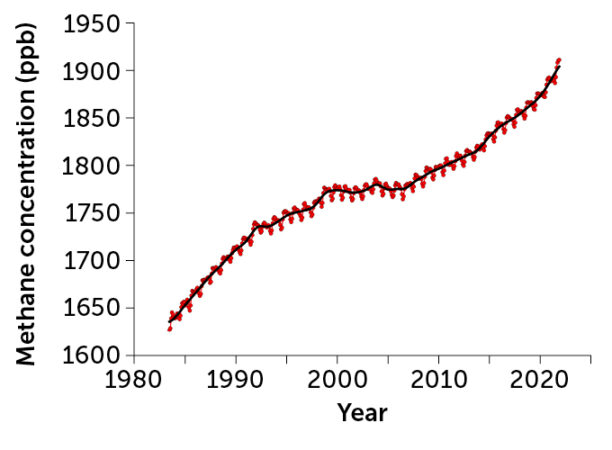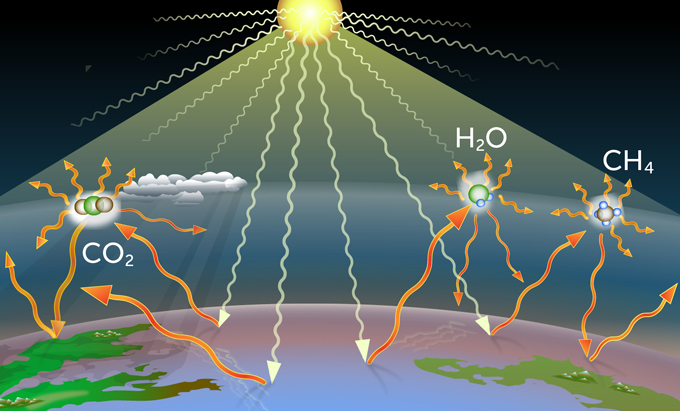
good discussion on Methane.
for the record, i consider the methane to global warming MEME even more absurd scientifically than the carbon dioxide to global warming MEME.
The geological record tells us the the science is Global Warming to higher carbon dioxide, and that we are geolgically deficient now in carbon dioxide and should really do something about all that like burn hydrocarbons a lot.
Methane on the other hand is a light gas and if it is hot, lighter still and constantly trying to go to the stratosphere. Real production is biological from every soil we have and yes it is rising. Measuring cow gas is a fools errand. now justify your scientific career a century from now.
It took a gang of simply normal folk to come up with all this who obviouly are part of a scheme nothing to do with science..
Methane may not warm the Earth quite as much as previously thought
The gas absorbs both longwave and shortwave radiation, with competing effects on climate
Methane, a potent greenhouse gas, is emitted through a number of human activities, including cattle farming.
GEORGE PACHANTOURIS/MOMENT/GETTY IMAGES
By Douglas Fox
APRIL 18, 2023 AT 9:00 AM
https://www.sciencenews.org/article/methane-warm-earth-atmosphere-radiation?ref=refind
Methane is a greenhouse gas with dual personalities. It heats Earth’s atmosphere 28 times as potently as carbon dioxide, gram for gram. But its absorption of the sun’s radiation high in the atmosphere also alters cloud patterns — casting a bit of shadow on its warming effect.
So rather than adding even more thermal energy to the atmosphere, as previously thought, methane’s solar absorption sets off a cascade of events that reduces its overall warming effect by about 30 percent, researchers report March 16 in Nature Geoscience.
“These are really interesting and important results,” says Rachael Byrom, a climate scientist at the CICERO Center for International Climate Research in Oslo who wasn’t involved in the new study. Nonetheless, she says, “methane still remains a really key gas that we need to target in emissions reductions.”
Humans are responsible for most of the methane entering the atmosphere, where it worsens global warming. Concentrations of the potent greenhouse gas have risen about 162 percent since preindustrial times, according to the U.S. National Oceanic and Atmospheric Administration.
The largest sources of anthropogenic methane include fossil fuel use, livestock, rice farming, landfills and biomass burning (SN: 9/29/22; SN: 7/14/20). Scientists fear that as warming triggers thaw of permafrost in the Arctic regions, this could also lead to increased methane emissions, as microbes in the soil consume dead plant material and release the gas (SN: 9/25/19).
Rising methane
The concentration of methane (CH4) in the atmosphere, measured in parts per billion, continues to increase. The gas absorbs radiation, worsening global warming.
Global monthly average of atmospheric methane, 1983–2021

XIN LAN/NOAA GLOBAL MONITORING LABORATORY
Greenhouse gases like methane exert their strongest effects by absorbing infrared “longwave” radiation emitted from the planet’s surface. Earth emits this longwave radiation when it is struck by “shortwave” radiation coming directly from the sun. Most studies of greenhouse gases focus on longwave absorption.
But scientists are learning that greenhouse gases, including methane, also absorb some of the sun’s shortwave radiation. Recent estimates suggested that methane might contribute up to 15 percent more thermal energy to the atmosphere than previously thought, due to this additional shortwave absorption.
However, the new study reveals that methane’s shortwave absorption has the opposite effect. This finding is based on a detailed analysis of the gas’s absorption at various wavelengths.
The result is “counterintuitive,” says climate scientist Robert Allen of the University of California, Riverside. It happens because of the way that methane’s shortwave absorbance affects clouds in different layers of the atmosphere, Allen and colleagues’ simulations suggest.
When methane absorbs shortwave radiation in the middle and upper troposphere, above about three kilometers, it further warms the air — leading to fewer clouds in that upper layer. And because methane absorbs shortwave radiation high up, less of that radiation penetrates down to the lower troposphere. This actually cools the lower troposphere, leading to more clouds in that layer.
These thicker low-level clouds reflect more of the sun’s shortwave radiation back out to space — meaning that less of this solar radiation reaches Earth’s surface, to be converted into longwave radiation.
Meanwhile, upper-level clouds, in addition to greenhouse gases, are known to absorb longwave radiation. So fewer of these clouds means that less of the longwave radiation emitted by Earth is captured in the atmosphere — and more of it escapes to space without contributing to climate change.
With methane’s shortwave absorption, “you expect warming of the climate system,” Allen says. “But these cloud adjustments actually overwhelm the heating due to absorption, leading to a cooling effect.”
Allen and his colleagues conducted the study using a computational model of Earth’s climate. When they took the traditional approach — considering only methane’s longwave absorbance — they estimated that the gas has caused 0.2 degrees Celsius of warming since preindustrial times, out of 1.06 degrees C total warming. But when they also included shortwave absorbance, methane’s contribution to warming fell to about 0.16 degrees C.
In addition to warming the planet, methane is also thought to increase global precipitation, due to greater evaporation of water with higher temperatures. But the researchers found that inclusion of shortwave absorbance also reduced methane’s precipitation effect, from a predicted 0.3 percent increase in precipitation (based on longwave absorbance alone), down to an increase of about 0.18 percent.

Greenhouse gases such as carbon dioxide (CO2), methane (CH4) and water vapor (H2O) exert their strongest warming effects (orange arrows) by absorbing longwave infrared radiation (darker orange arrows) emitted by Earth as it is struck by shortwave radiation (light yellow arrows) from the sun. But the gases can also directly absorb shortwave radiation from the sun, modifying methane’s climate effects in surprising ways, a study finds)
It will be important to include methane’s shortwave effects in future climate projections, says Daniel Feldman, an atmospheric scientist at the Lawrence Berkeley National Laboratory in California, who was not involved in the study. But he thinks that more work needs to be done to clarify those effects.
The new study analyzed methane’s shortwave impact using only one comprehensive model that included both the atmosphere and ocean, he says. “I would just like to see that sort of analysis done across multiple models,” increasing confidence in the results.
No comments:
Post a Comment